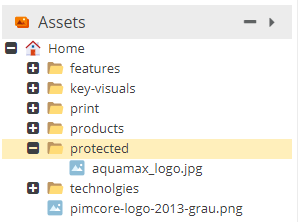Restricting Public Asset Access
Pimcore has following default behavior in terms of asset delivery:
All Data that is stored as Pimcore Assets can be accessed via its URL (e.g. https://mydomain.com/my-assetfolder/my-asset.jpg) and therefore is public available without login or other access restriction!
As a consequence confidential data must not be stored as Pimcore Assets without additional protection measures.
The reason for this wanted behavior is performance. Delivering an asset directly via the web server needs significantly less resources than starting a php process for every asset request (especially when it comes to delivering thumbnails).
If further restriction is needed, Pimcore provides two options for doing so:
Option 1 - Restricting access to certain assets completely
All confidential assets need to be stored within one (or a few) folder(s), e.g. within /protected (to set up Pimcore
backend permissions this is necessary anyway).

Apache
In the .htaccess of the project, the access to this folder has to be restricted with an additional rewrite rule. It is
important, that this rule is placed in front of the rewrite rule for asset delivery.
...
RewriteRule ^protected/.* - [F,L]
RewriteRule ^var/.*/protected(.*) - [F,L]
RewriteRule ^cache-buster\-[\d]+/protected(.*) - [F,L]
# ASSETS: check if request method is GET (because of WebDAV) and if the requested file (asset) exists on the filesystem, if both match, deliver the asset directly
...
Nginx
Add the following parts to your Nginx configuration directly after the index directive.
location ~ ^/protected/.* {
return 403;
}
location ~ ^/var/.*/protected(.*) {
return 403;
}
location ~ ^/cache-buster\-[\d]+/protected(.*) {
return 403;
}
A full configuration example can be found on this page.
Because of this rule, all assets located within /protected (also all their thumbnails) are not delivered via the web
server anymore. As a consequence also using the direct link for downloading or using the Pimcore generated img tags for
thumbnails cannot be used anymore. All delivery of these assets has to be done manually via a custom controller action.
Option 2 - Checking permissions before delivery
This option does not restrict the delivery in general, but routes the asset request to a controller action that can check access permissions with custom business logic and then deliver the asset or not.
Again all confidential assets need to be stored within one (or a few) folders, e.g. within /protected.

Apache
In the .htaccess of the project, requests to assets of this folder need to be routed to index.php. Again, it is
important, that this rule is placed in front of the rewrite rule for asset delivery.
...
RewriteRule ^protected/(.*) %{ENV:BASE}/index.php [L]
RewriteRule ^var/.*/protected(.*) - [F,L]
RewriteRule ^cache-buster\-[\d]+/protected(.*) - [F,L]
# ASSETS: check if request method is GET (because of WebDAV) and if the requested file (asset) exists on the filesystem, if both match, deliver the asset directly
...
Nginx
Add the following parts to your Nginx configuration directly after the index directive.
rewrite ^(/protected/.*) /index.php$is_args$args last;
location ~ ^/var/.*/protected(.*) {
return 403;
}
location ~ ^/cache-buster\-[\d]+/protected(.*) {
return 403;
}
A full configuration example can be found on this page.
In the application, there has to be a route in (config/routing.yaml) and a controller action that handles the request, e.g. like the following:
# config/routing.yaml
# important this has to be the first route in the file!
asset_protect:
path: /protected/{path}
defaults: { _controller: MyAssetController:protectedAsset }
requirements:
path: '.*'
<?php
namespace App\Controller;
use Pimcore\Controller\FrontendController;
use Pimcore\Model\Asset;
use Symfony\Component\HttpFoundation\BinaryFileResponse;
use Symfony\Component\HttpFoundation\Request;
use Symfony\Component\HttpKernel\Exception\AccessDeniedHttpException;
use Symfony\Component\Routing\Matcher\UrlMatcher;
use Symfony\Component\Routing\RouteCollection;use Symfony\Component\Templating\Storage\Storage;
class MyAssetController extends FrontendController
{
public function protectedAssetAction(Request $request)
{
// IMPORTANT!
// Add your code here to check permission!
// the following code is responsible to deliver asset & thumbnail contents
// modify it the way you need it for your use-case
$pathInfo = $request->getPathInfo();
$asset = Asset::getByPath($pathInfo);
if ($asset){
$stream = $asset->getStream();
return new StreamedResponse(function () use ($stream) {
fpassthru($stream);
}, 200, [
'Content-Type' => 'application/pdf',
]);
} elseif (preg_match('@.*/(image|video)-thumb__[\d]+__.*@', $pathInfo, $matches)) {
$storage = Storage::get('thumbnail');
$storagePath = urldecode($pathInfo);
if($storage->fileExists($storagePath)){
$stream = $storage->readStream($storagePath);
return new StreamedResponse(function () use ($stream) {
fpassthru($stream);
}, 200, [
'Content-Type' => $storage->mimeType($storagePath),
]);
} else {
$pimcoreThumbnailRoute = '_pimcore_service_thumbnail';
$route = $this->get('router')->getRouteCollection()->get($pimcoreThumbnailRoute);
$collection = new RouteCollection();
$collection->add($pimcoreThumbnailRoute, $route);
$matcher = new UrlMatcher($collection, $this->get('router')->getContext());
try {
$parameters = $matcher->matchRequest($request);
$response = $this->forward('PimcoreCoreBundle:PublicServices:thumbnail', $parameters);
return $response;
} catch (\Exception $e) {
// nothing to do
}
}
}
throw new AccessDeniedHttpException('Access denied.');
}
}
Of course this option has significant impact on server load and delivery performance of assets (and thumbnails). Therefore it is not suggested to deliver all assets that way but only the confidential ones!